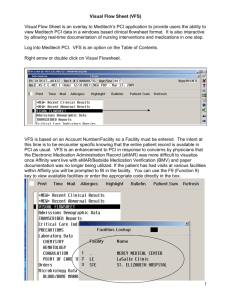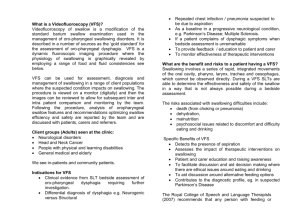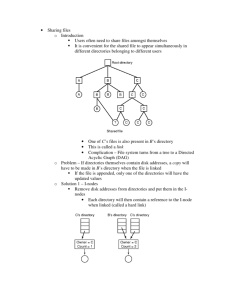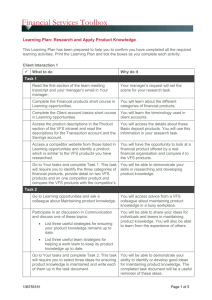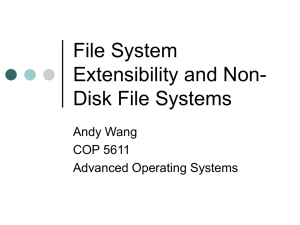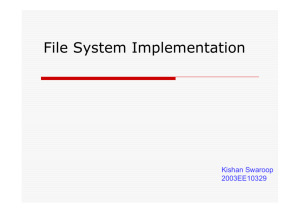PowerPoint 2003
advertisement
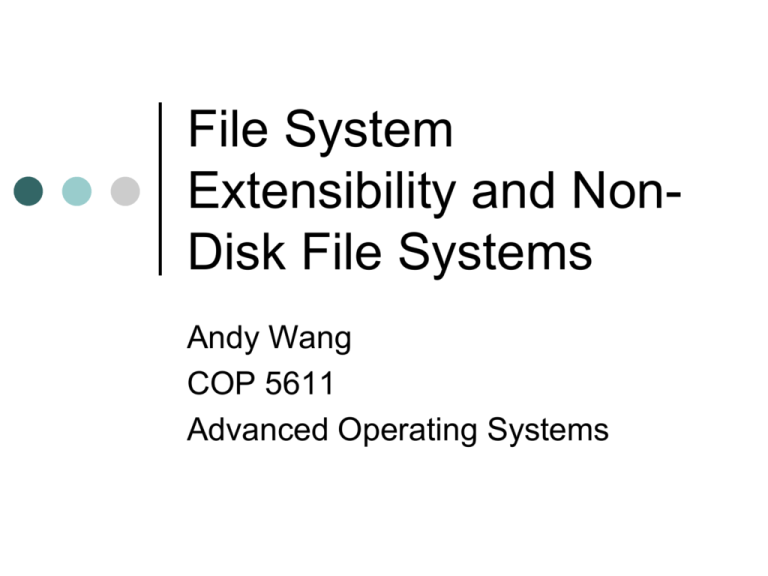
File System Extensibility and NonDisk File Systems Andy Wang COP 5611 Advanced Operating Systems Outline File system extensibility Non-disk file systems File System Extensibility No file system is perfect So the OS should make multiple file systems available And should allow for future improvements to file systems FS Extensibility Approaches Modify an existing file system Virtual file systems Layered and stackable FS layers Modifying Existing FSes Make the changes to an existing FS + – – – Reuses code But changes everyone’s file system Requires access to source code Hard to distribute Virtual File Systems Permit a single OS to run multiple file systems Share the same high-level interface OS keeps track of which files are instantiated by which file system Introduced by Sun / A 4.2 BSD File System / 4.2 BSD File System B NFS File System Goals of VFS Split FS implementation-dependent and -independent functionality Support important semantics of existing file systems Usable by both clients and servers of remote file systems Atomicity of operation Good performance, re-entrant, no centralized resources, “OO” approach Basic VFS Architecture Split the existing common Unix file system architecture Normal user file-related system calls above the split File system dependent implementation details below I_nodes fall below open()and read()calls above VFS Architecture Diagram System Calls V_node Layer PC File System 4.2 BSD File System NFS Floppy Disk Hard Disk Network Virtual File Systems Each VFS is linked into an OSmaintained list of VFS’s Each VFS has a pointer to its data First in list is the root VFS Which describes how to find its files Generic operations used to access VFS’s V_nodes The per-file data structure made available to applications Has public and private data areas Public area is static or maintained only at VFS level No locking done by the v_node layer BSD vfs rootvfs vfs_next vfs_vnodecovered … mount BSD vfs_data mount 4.2 BSD File System NFS BSD vfs rootvfs vfs_next vfs_vnodecovered … create root / vfs_data v_node / v_vfsp v_vfsmountedhere … v_data i_node / mount 4.2 BSD File System NFS BSD vfs rootvfs vfs_next vfs_vnodecovered … create dir A vfs_data v_node A v_node / v_vfsp v_vfsp v_vfsmountedhere v_vfsmountedhere … … v_data v_data i_node / mount 4.2 BSD File System i_node A NFS rootvfs BSD vfs NFS vfs vfs_next vfs_next vfs_vnodecovered vfs_vnodecovered … … vfs_data vfs_data mount NFS v_node A v_node / v_vfsp v_vfsp v_vfsmountedhere v_vfsmountedhere … … v_data v_data i_node / mount 4.2 BSD File System i_node A mntinfo NFS rootvfs BSD vfs NFS vfs vfs_next vfs_next vfs_vnodecovered vfs_vnodecovered … … vfs_data vfs_data create dir B v_node A v_node B v_vfsp v_vfsp v_vfsp v_vfsmountedhere v_vfsmountedhere v_vfsmountedhere … … … v_data v_data v_data v_node / i_node / mount 4.2 BSD File System i_node A i_node B mntinfo NFS rootvfs BSD vfs NFS vfs vfs_next vfs_next vfs_vnodecovered vfs_vnodecovered … … vfs_data vfs_data read root / v_node A v_node B v_vfsp v_vfsp v_vfsp v_vfsmountedhere v_vfsmountedhere v_vfsmountedhere … … … v_data v_data v_data v_node / i_node / mount 4.2 BSD File System i_node A i_node B mntinfo NFS rootvfs BSD vfs NFS vfs vfs_next vfs_next vfs_vnodecovered vfs_vnodecovered … … vfs_data vfs_data read dir B v_node A v_node B v_vfsp v_vfsp v_vfsp v_vfsmountedhere v_vfsmountedhere v_vfsmountedhere … … … v_data v_data v_data v_node / i_node / mount 4.2 BSD File System i_node A i_node B mntinfo NFS Does the VFS Model Give Sufficient Extensibility? VFS allows us to add new file systems But not as helpful for improving existing file systems What can be done to add functionality to existing file systems? Layered and Stackable File System Layers Increase functionality of file systems by permitting composition One file system calls another, giving advantages of both Requires strong common interfaces, for full generality Layered File Systems Windows NT is an example of layered file systems File systems in NT ~= device drivers Device drivers can call one another Using the same interface Windows NT Layered Drivers Example user-level process system services file system driver multivolume disk driver disk driver I/O manager user mode kernel mode Another Approach: Stackable Layers More explicitly built to handle file system extensibility Layered drivers in Windows NT allow extensibility Stackable layers support extensibility Stackable Layers Example File System Calls File System Calls VFS Layer VFS Layer Compression LFS LFS How Do You Create a Stackable Layer? Write just the code that the new functionality requires Pass all other operations to lower levels (bypass operations) Reconfigure the system so the new layer is on top User File System Directory Layer Directory Layer Compress Layer Encrypt Layer UFS Layer LFS Layer What Changes Does Stackable Layers Require? Changes to v_node interface For full value, must allow expansion to the interface Changes to mount commands Serious attention to performance issues Extending the Interface New file layers provide new functionality Possibly requiring new v_node operations Each layer needs to deal with arbitrary unknown operations Bypass v_node operation Handling a Vnode Operation A layer can do three things with a v_node operation: 1. Do the operation and return 2. Pass it down to the next layer 3. Do some work, then pass it down The same choices are available as the result is returned up the stack Mounting Stackable Layers Each layer is mounted with a separate command Essentially pushing new layer on stack Can be performed at any normal mount time Not just on system build or boot What Can You Do With Stackable Layers? Leverage off existing file system technology, adding Compression Encryption Object-oriented operations File replication All without altering any existing code Performance of Stackable Layers To be a reasonable solution, per-layer overhead must be low In UCLA implementation, overhead is ~1-2%/layer In system time, not elapsed time Elapsed time overhead ~.25%/layer Application dependent, of course Additional References FUSE (Stony Brook) Linux implementation of stackable layers Subtle issues Duplicate caching • Encrypted version • Compressed version • Plaintext version File Systems Using Other Storage Devices All file systems discussed so far have been disk-based The physics of disks has a strong effect on the design of the file systems Different devices with different properties lead to different FSes Other Types of File Systems RAM-based Disk-RAM-hybrid Flash-memory-based Network/distributed discussion of these deferred Fitting Various File Systems Into the OS Something like VFS is very handy Otherwise, need multiple file access interfaces for different file systems With VFS, interface is the same and storage method is transparent Stackable layers makes it even easier Simply replace the lowest layer In-core File Systems Store files in memory, not on disk + + – – – Fast access and high bandwidth Usually simple to implement Hard to make persistent Often of limited size May compete with other memory needs Where Are In-core File Systems Useful? When brain-dead OS can’t use all memory for other purposes For temporary files For files requiring very high throughput In-core FS Architectures Dedicated memory architectures Pageable in-core file system architectures Dedicated Memory Architectures Set aside some segment of physical memory to hold the file system Usable only by the file system Either it’s small, or the file system must handle swapping to disk RAM disks are typical examples Pageable Architectures Set aside some segment of virtual memory to hold the file system Share physical memory system Can be much larger and simpler More efficient use of resources Examples: UNIX /tmp file systems Basic Architecture of Pageable Memory FS Uses VFS interface Inherits most of code from standard disk-based filesystem Including caching code Uses separate process as “wrapper” for virtual memory consumed by FS data How Well Does This Perform? Not as well as you might think Around 2 times disk based FS Why? Because any access requires two memory copies 1. From FS area to kernel buffer 2. From kernel buffer to user space Fixable if VM can swap buffers around Other Reasons Performance Isn’t Better Disk file system makes substantial use of caching Which is already just as fast But speedup for file creation/deletion is faster requires multiple trips to disk Disk/RAM Hybrid FS Conquest File System http://www.cs.fsu.edu/~awang/conquest Observations Disk is cheaper in capacity Memory is cheaper in performance So, why not combine their strengths? Conquest Design and build a disk/persistentRAM hybrid file system Deliver all file system services from memory, with the exception of highcapacity storage User Access Patterns Small files Take little space (10%) Represent most accesses (90%) Large files Take most space Mostly sequential accesses Except database applications Files Stored in Persistent RAM Small files (< 1MB) No seek time or rotational delays Fast byte-level accesses Contiguous allocation Metadata Fast synchronous update No dual representations Executables and shared libraries In-place execution Memory Data Path of Conquest Conventional file systems Conquest Memory Data Path Storage requests Storage requests IO buffer management Persistence support IO buffer Battery-backed RAM Persistence support Disk management Disk Small file and metadata storage Large-File-Only Disk Storage Allocate in big chunks Lower access overhead Reduced management overhead No fragmentation management No tricks for small files Storing data in metadata No elaborate data structures Wrapping a balanced tree onto disk cylinders Sequential-Access Large Files Sequential disk accesses Near-raw bandwidth Well-defined readahead semantics Read-mostly Little synchronization overhead (between memory and disk) Disk Data Path of Conquest Conventional file systems Conquest Disk Data Path Storage requests Storage requests IO buffer management IO buffer management IO buffer Persistence support IO buffer Battery-backed RAM Small file and metadata storage Disk management Disk management Disk Disk Large-file-only file system Random-Access Large Files Random access? Common def: nonsequential access A movie has ~150 scene changes MP3 stores the title at the end of the files Near Sequential access? Simplify large-file metadata representation significantly PostMark Benchmark ISP workload (emails, web-based transactions) Conquest is comparable to ramfs At least 24% faster than the LRU disk cache 9000 8000 7000 6000 5000 trans / sec 4000 3000 2000 1000 0 250 MB working set with 2 GB physical RAM 5000 10000 15000 20000 25000 30000 files SGI XFS reiserfs ext2fs ramfs Conquest PostMark Benchmark When both memory and disk components are exercised, Conquest can be several times faster than ext2fs, reiserfs, and SGI XFS 10,000 files, 5000 4000 <= RAM > RAM 3.5 GB working set with 2 GB physical RAM 3000 trans / sec 2000 1000 0 0.0 1.0 2.0 3.0 4.0 5.0 6.0 7.0 8.0 9.0 percentage of large files SGI XFS reiserfs ext2fs Conquest 10.0 PostMark Benchmark When working set > RAM, Conquest is 1.4 to 2 times faster than ext2fs, reiserfs, and SGI XFS 10,000 files, 3.5 GB working set with 2 GB physical RAM 120 100 80 trans / sec 60 40 20 0 6.0 7.0 8.0 9.0 10.0 percentage of large files SGI XFS reiserfs ext2fs Conquest Flash Memory File Systems What is flash memory? Why is it useful for file systems? A sample design of a flash memory file system Flash Memory A form of solid-state memory similar to ROM Holds data without power supply Reads are fast Can be written once, more slowly Can be erased, but very slowly Limited number of erase cycles before degradation (10,000 – 100,000) Physical Characteristics NOR Flash Used in cellular phones and PDAs Byte-addressible Can write and erase individual bytes Can execute programs NAND Flash Used in digital cameras and thumb drives Page-addressible 1 flash page ~= 1 disk block (1-4KB) Cannot run programs Erased in flash blocks Consists of 4 - 64 flash pages May not be atomic Writing In Flash Memory If writing to empty flash page (~disk block), just write If writing to previously written location, erase it, then write While erasing a flash block May access other pages via other IO channels Number of channels limited by power (e.g., 16 channels max) Implications of Slow Erases The use of flash translation layer (FTL) Write new version elsewhere Erase the old version later Implications of Limited Erase Cycles Wear-leveling mechanism Spread erases uniformly across storage locations Multi-level cells Use multiple voltage levels to represent bits Implications of MLC Higher density lowers price/GB Need exponential number of voltage levels to for linear increase in density Maxed out quickly Performance Characteristics NOR Read Write Erase Power 80 ns/8-word (16 bits/word) page 25 s/(4KB + 128B) page Bandwidth 200 MB/s 160 MB/s Latency 6 s/word 200 s/page Bandwidth <0.5 MB/s 20 MB/s 750 ms/64Kword block 1.5 ms/(256KB + 8KB) Bandwidth 175 KB/s 172 MB/s Active 106 mW 99 mW 54 W 165 W $30/GB $1/GB Latency Latency Idle Cost NAND Pros/Cons of Flash Memory + + + + + – – – Small and light Uses less power than disk Read time comparable to DRAM No rotation/seek complexities No moving parts (shock resistant) Expensive (compared to disk) Erase cycle very slow Limited number of erase cycles Flash Memory File System Architectures One basic decision to make Is flash memory disk-like? Or memory-like? Should flash memory be treated as a separate device, or as a special part of addressable memory? Journaling Flash File System (JFFS) Treats flash memory as device As opposed to directly addressable memory Motivation FTL effectively is journaling-like Running a journaling file system on the top of it is redundant JFFS1 Design One data structure—node LFS-like A node with a new version makes the older version obsolete Many nodes are associated with an inode i-node Design Issues An i-node contains Its name Parent’s i-node number (a back pointer) Ext2 Directory data block location file1 file1 file i-node i-nodelocation number data block location index block location index block location index block location i-node file1 file2 file2 file i-node i-nodelocation number JFFS Directory file1 file parent’s i-node i-node location number Implications data block location data block location index block location index block location index block location i-node No intermediate directories to modify when adding files Need scanning at mount time to build a FS in RAM No hard links Node Design Issues A node may contain data range for an i-node With an associated file offset Use version stamps to indicate updates Garbage Collection Merge nodes with smaller data ranges into fewer nodes with longer data ranges Garbage Collection Problem A node may be stored across a flash block boundary Solution Max node size = ½ flash block size JFFS1 Limitations Always garbage collect the oldest block Even if the block is not modified No data compression No hard links Poor performance for renames JFFS2 Wear Leveling For 1/100 occasions, garbage collect an old clean block JFFS2 Data Compression Problems When merging nodes, the resulting node may not compress as well May not be portable due to differences in compression libraries Does not support mmap, which requires page alignment Problems with versionstamp-based updates Dead blocks are determined at mount time (scanning occurs) If a directory is detected to be deleted, scanning needs to restart, since its children files are deleted as well Problems with versionstamp-based updates Truncate, seek, and append… Old data may show through holes within a file… A hack Add nodes to indicate holes Additional References UBIFS (JFFS3) YAFFS BTRFS

